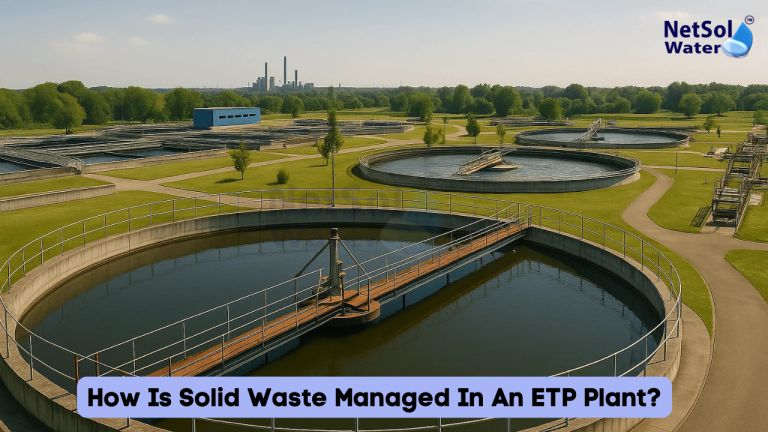
Everything from big trash to fine sludge is considered solid waste. These solids must be eliminated gradually in an ETP Plant. Large solid particles in screens are first eliminated by the system. Heavy grit is then shed by the ETP Plants in grit chambers. Finer solids are later allowed to accumulate & collected in sedimentation tanks by the system. The ETP Plant assembles even minor particles by implementing natural science. That step creates sludge that requires additional attention. The sludge is then thickened & subsequently dewatered by the ETP Plants. This step trims/cut down overall volume by weight of solid waste. The processed sludge is then sent by the system for reuse or safe disposal. In this blog we will discuss how is solid waste managed In an ETP plant?
Every step counts. ETP Plant design that works saves energy & money. Water purity is also safeguarded. Equipment safety depends on proper handling. It complies with regulations as well. Commercial RO Plant considers every stage when designing ETP Plants. Our professionals apply in-depth knowledge to every plant. They mainly focus on the progress of solid garbage. The intake is where this flow begins, & the disposal is where it terminates.
Grit Cleaning along with Screening Process
The plant functions properly when big, heavy particles are managed. Let’s examine a few crucial steps.
1) Screening through Coarser Solid Particles
Coarse screens are implemented to start an ETP plant. These screens catch rags & sticks. Applying water jets, operators remove the stuck material. This prevents downstream pump damage.
2) Fine Particle Filtration/Screening
The flow then goes via fine filters. These screens capture tiny particles. Automated rakes/sweeping are applied by staff to remove the accumulated matter. These screens keep pipes from becoming clogged.
3) Grit Removal Chamber
The waste containing stream passes across a grit chamber after screening-out process. Bits of lighter organic matter stay suspended. Operators use scraper arms to remove the settled grit.
By eliminating abrasive grit & debris, this step prolongs the life of pumps & mixers.
The primary/initial sedimentation
Later steps are less burdened as suspended solids settle. Let’s examine a few settlement techniques.
1) Simple Tanks for Sedimentation
Slowly, water enters a huge tank. Gravitational force leads to in solid wastes being settled down at the bottom-ground. The following step is reached via clear water. Employees periodically drain the settled sludge.
2) Settling System of Tubes
Tubes settling systems support in the fast settling of particles in certain Effluent Treatment Plants. The surface area of these angled tubes is increased. The tubes allow solids to flow into a hopper. This design speeds up operation & reduces tank space. Good settlement here lowers the cost of both energy & chemicals later on.
Solid Wastes for Biological Microbial Treatment
Organic particulate matter is simply broken down in water by the means of micro-biological activity. Let’s simplify through investigation of various tasks linked to solids management.
1) Sludge Activation Process
In order to cultivate bacteria in the reactor, the plant increases air circulation. Dissolved organics are the food source for these bacteria. After that, the mixture enters a secondary clarifier. The biomass becomes sludge there.
2) A bioreactor with membranes
Water is filtered through tiny pores in a membrane bioreactor. Almost all microorganisms are kept within the reactor. The process produces high-quality water with less sludge.
The ETP Plant is more effective along with it produces cleaner water when these sediments are handled properly.
Process of Sludge Thickening along with Dewatering Sludge
Sludge water removal lowers disposal expenses. Let’s examine some thickening strategies.
1) Gravity Thickening
Solids sink in a tank containing sludge. Dewatering units receive the thicker sludge. Overflow is sent back to the factory for further processing.
2) Mechanical Dewatering
Water is extracted from the plant using belt presses or centrifuges. The pressed cake weights fewer pounds & dries more quickly. Employees remove the cake for recycling or ultimate destruction. This step reduces transportation costs & shapes the final solid product’s quality.
Final Elimination & Recovery of Resources
The loop is closed by a safe final utilization or disposal. Let’s examine a few possibilities.
1) Landfill Disposal
Simplified Sludge that has been almost dewatered to the last degree may ultimately be drained out in a landfill. Operators make sure it complies with disposal safety regulations. Soil & water surrounding the site are protected by long-term monitoring.
2) Composting & Soil Resolution
In an uncovered compost pile, the sludge frequently combines with other organic materials. Stable compost is created when materials is broken down by microbes. In agro-industries, new modern technologies involve these composts acts as an organic soil conditioner.
Sludge resource recovery reduces waste volume & adds value.
Conclusion
Clear & straightforward sequence of events starting from screening till the disposal is very much essential to solid waste management in an ETP Plant. One of the top producers of ETP Plant systems that carefully manage each stage is Commercial RO Plant. An effective ETP reduces risk as well as converts waste into goods that are valuable.In above blog you read how is solid waste managed in an ETP plant. Please contact us right now to find out more about how an ETP might meet your needs. To discuss customized ETP Plant solutions plus comprehensive advice on solid waste disposal in your business, schedule an assessment with Commercial RO Plant business.
